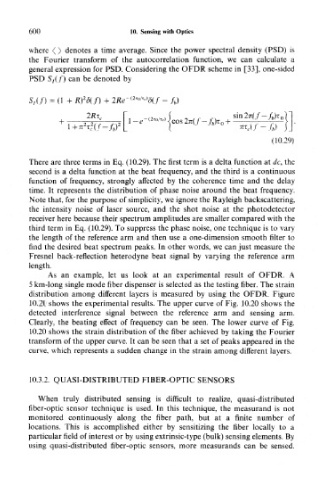Page 616 - Introduction to Information Optics
P. 616
10. Sensing with Optics
where < > denotes a time average. Since the power spectral density (PSD) is
the Fourier transform of the autocorrelation function, we can calculate a
general expression for PSD. Considering the OFDR scheme in [33], one-sided
PSD Si(f) can be denoted by
(10.29)
There are three terms in Eq. (10.29). The first term is a delta function aide, the
second is a delta function at the beat frequency, and the third is a continuous
function of frequency, strongly affected by the coherence time and the delay
time. It represents the distribution of phase noise around the beat frequency.
Note that, for the purpose of simplicity, we ignore the Rayleigh backscattering,
the intensity noise of laser source, and the shot noise at the photodetector
receiver here because their spectrum amplitudes are smaller compared with the
third term in Eq. (10.29). To suppress the phase noise, one technique is to vary
the length of the reference arm and then use a one-dimension smooth filter to
find the desired beat spectrum peaks. In other words, we can just measure the
Fresnel back-reflection heterodyne beat signal by varying the reference arm
length.
As an example, let us look at an experimental result of OFDR. A
5 km-long single mode fiber dispenser is selected as the testing fiber. The strain
distribution among different layers is measured by using the OFDR. Figure
10.20 shows the experimental results. The upper curve of Fig. 10.20 shows the
detected interference signal between the reference arm and sensing arm.
Clearly, the beating effect of frequency can be seen. The lower curve of Fig.
10.20 shows the strain distribution of the fiber achieved by taking the Fourier
transform of the upper curve. It can be seen that a set of peaks appeared in the
curve, which represents a sudden change in the strain among different layers.
10.3.2. QUASI-DISTRIBUTED FIBER-OPTIC SENSORS
When truly distributed sensing is difficult to realize, quasi-distributed
fiber-optic sensor technique is used. In this technique, the measurand is not
monitored continuously along the fiber path, but at a finite number of
locations. This is accomplished either by sensitizing the fiber locally to a
particular field of interest or by using extrinsic-type (bulk) sensing elements. By
using quasi-distributed fiber-optic sensors, more measurands can be sensed.

